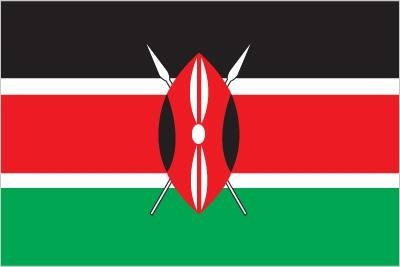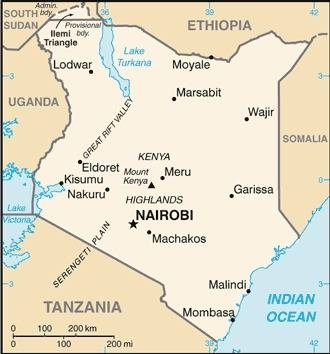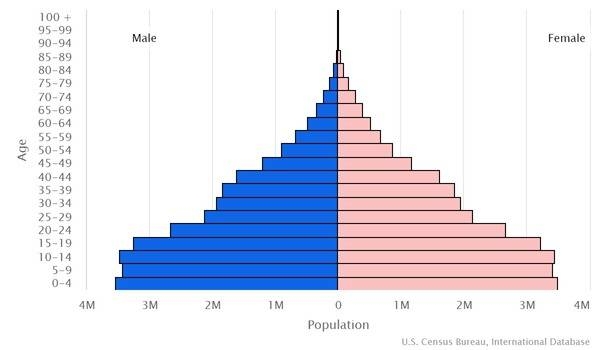Country Summary




Introduction
Background
Kenya gained independence from the United Kingdom in 1963. In August 2010, Kenyans overwhelmingly adopted a new constitution in a national referendum. The new constitution introduced additional checks and balances to executive power and devolved power and resources to 47 newly created counties.
Geography
Area
total: 580,367 sq km
land: 569,140 sq km
water: 11,227 sq km
Climate
varies from tropical along coast to arid in interior
Natural resources
limestone, soda ash, salt, gemstones, fluorspar, zinc, diatomite, gypsum, wildlife, hydropower
People and Society
Population
55,864,655 (2022 est.)
Ethnic groups
Kikuyu 17.1%, Luhya 14.3%, Kalenjin 13.4%, Luo 10.7%, Kamba 9.8%, Somali 5.8%, Kisii 5.7%, Mijikenda 5.2%, Meru 4.2%, Maasai 2.5%, Turkana 2.1%, non-Kenyan 1%, other 8.2% (2019 est.)
Languages
English (official), Kiswahili (official), numerous indigenous languages
Religions
Christian 85.5% (Protestant 33.4%, Catholic 20.6%, Evangelical 20.4%, African Instituted Churches 7%, other Christian 4.1%), Muslim 10.9%, other 1.8%, none 1.6%, don't know/no answer 0.2% (2019 est.)
Population growth rate
2.12% (2022 est.)
Government
Government type
presidential republic
Capital
name: Nairobi
Executive branch
chief of state: President William RUTO (since 13 September 2022); note - the president is both chief of state and head of government
head of government: President William RUTO (since 13 September 2022)
Legislative branch
description: bicameral Parliament consists of:
Senate (68 seats; 47 members directly elected in single-seat constituencies by simple majority vote and 20 directly elected by proportional representation vote - 16 women, 2 representing youth, 2 representing the disabled, and one Senate speaker; members serve 5-year terms)
National Assembly (350 seats; 290 members directly elected in single-seat constituencies by simple majority vote, 47 women in single-seat constituencies elected by simple majority vote, and 12 members nominated by the National Assembly - 6 representing youth and 6 representing the disabled, and one Assembly speaker; members serve 5-year terms)
Economy
Economic overview
one of the fastest growing Sub-Saharan economies; hard-hit by COVID-19 disruptions and locust infestation, somewhat offset by agricultural growth; environmentally fragile economy; persistent poverty; better financial confidence; significant remittances
Real GDP (purchasing power parity)
$226.94 billion (2020 est.)
Real GDP per capita
$4,200 (2020 est.)
Agricultural products
sugar cane, milk, maize, potatoes, bananas, camel milk, cassava, sweet potatoes, mangoes/guavas, cabbages
Industries
small-scale consumer goods (plastic, furniture, batteries, textiles, clothing, soap, cigarettes, flour), agricultural products, horticulture, oil refining; aluminum, steel, lead; cement, commercial ship repair, tourism, information technology
Exports
$11.49 billion (2019 est.)
Exports - partners
Uganda 10%, United States 9%, Netherlands 8%, Pakistan 7%, United Kingdom 6%, United Arab Emirates 6%, Tanzania 5% (2019)
Exports - commodities
tea, cut flowers, refined petroleum, coffee, titanium (2019)
Imports
$20.41 billion (2019 est.)
Imports - partners
China 24%, United Arab Emirates 10%, India 10%, Saudi Arabia 7%, Japan 5% (2019)
Imports - commodities
refined petroleum, cars, packaged medicines, wheat, iron products (2019)
Exchange rates
Kenyan shillings (KES) per US dollar -
Page last updated: Wednesday, September 14, 2022
